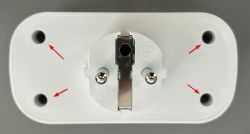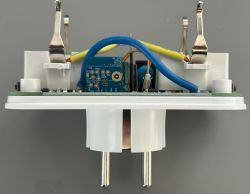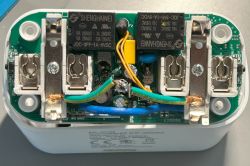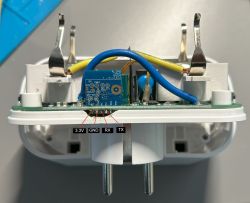Here is how to flash the Denver SHP-200MK2 Smart Wi-Fi 2in1 plug with OpenBeken:

The plug casing is secured with four screws on the back:

Inside, a WB2S module is found:

The PCB itself is labelled as WG-05E:

The UART pins are not directly exposed, and the PCB seems to be soldered to the plug’s prongs, so desoldering didn’t look like an easy option.

I decided to simply cut a bit of the plastic in front to expose the pins:

I soldered four wires to the pins (3.3V, GND, RX, TX) and connected to an USB UART. Then I used the BK7231 GUI Flash Tool to flash OpenBeken.
The extracted OBK template is as follows:
I have inserted the following code in the autoexec.bat file to have the Wi-Fi LED off when the plug is connected to Wi-Fi, and to enable energy data.
The original firmware is attached for reference.

The plug casing is secured with four screws on the back:

Inside, a WB2S module is found:

The PCB itself is labelled as WG-05E:

The UART pins are not directly exposed, and the PCB seems to be soldered to the plug’s prongs, so desoldering didn’t look like an easy option.

I decided to simply cut a bit of the plastic in front to expose the pins:

I soldered four wires to the pins (3.3V, GND, RX, TX) and connected to an USB UART. Then I used the BK7231 GUI Flash Tool to flash OpenBeken.
The extracted OBK template is as follows:
{
"vendor": "Denver",
"bDetailed": "0",
"name": "Smart Wi-Fi 2in1 plug",
"model": "SHP-200MK2",
"chip": "BK7231T",
"board": "TODO",
"flags": "1024",
"keywords": [
"Wi-Fi plug",
"Powermeter"
],
"pins": {
"6": "BL0937SEL;0",
"7": "BL0937CF1;0",
"8": "BL0937CF;0",
"10": "Btn;2",
"11": "WifiLED_n;0",
"23": "Btn;1",
"24": "Rel;2",
"26": "Rel;1"
},
"command": "",
"image": "https://obrazki.elektroda.pl/YOUR_IMAGE.jpg",
"wiki": "https://www.elektroda.com/rtvforum/topic_YOUR_TOPIC.html"
}
I have inserted the following code in the autoexec.bat file to have the Wi-Fi LED off when the plug is connected to Wi-Fi, and to enable energy data.
alias mode_wifi setPinRole 11 WifiLED_n
alias mode_led_off setPinRole 11 AlwaysHigh
// at reboot, set WiFiLEd
mode_wifi
// then, setup handlers
addChangeHandler WiFiState == 4 mode_led_off
addChangeHandler WiFiState != 4 mode_wifi
startDriver ntp
ntp_timeZoneOfs 1:00
The original firmware is attached for reference.






